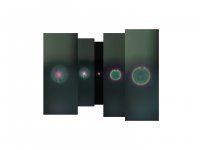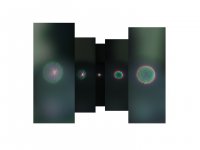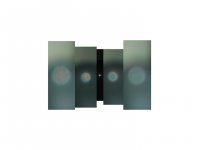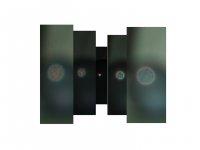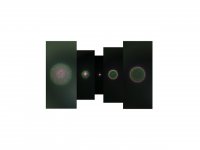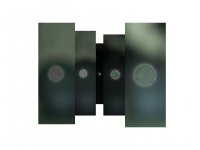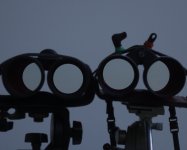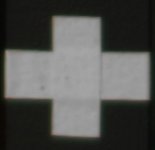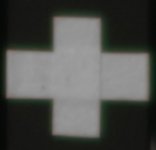Henry,
Many thanks for the analysis. I confess I still struggle to correlate defocussed stars with normal observation but I must congratulate you on the excellent images that help me get a step closer.
You mention the lack of sharpness, did you estimate full and reduced aperture resolutions?
David
David,
I’m back at the computer. I didn't photograph the resolution tests, but here are a couple of extreme crops of the center cross of my CA target, FL on the left and HT on the right, both at full aperture. They might give you an idea of the differences visible between the FL and HT on the USAF 1951 Resolution Test Pattern at very high magnification. Both show an odd green fringe at best focus, much worse in the HT. A green fringe doesn’t make much sense at best focus where you expect green to be a focused color, but there it is. I suspect it has something to do with spherochromatism causing green from the outside part of the objective to swing very far out of focus compared to green from the central part, but that's pure speculation. The elements of the USAF 1951 chart viewed through the HT at high magnification look like gray/green bars surrounded by a green haze. The FL shows some of the same effect, but much less. At high magnification most binoculars at best focus show a red or purple fringe impinging on dark gray bars.
The measured resolution of the HT at full aperture on the USAF chart is 3.5”. That may not seem too bad for a binocular even though the high magnification image looks terrible. However, that raw number is actually poor for a 54mm aperture. It corresponds to 189/D (with D the diameter of the objective in millimeters). The 8x56 FL measured at the same time was 2.7” (151/D), better but not that great either. The best binoculars I’ve measured come in around 125/D at full aperture, within spitting distance of the best low aberration telescopes measured on the same chart (115/D).
Unfortunately I neglected to measure the stopped down resolution of the HT, but given the appearance of the 22mm star-test I would expect it to be somewhat worse than the FL, maybe around 135-140/D (with D=22mm), around 6.2”.
Those results don’t seem to me to explain why, for my eyes, the HT had poorer resolving power in bright light than the FL at 8x. You may know that I don’t place much confidence in resolution comparisons of binoculars at low magnification using the USAF chart. I don’t think it makes a good resolution target at low magnification because the smallest resolvable elements become too tiny and crammed together. For my eyes (around 90” acuity using a line pair per millimeter chart like the USAF 1951) there is virtually never a consistent repeatable difference in resolution among decent quality binoculars of the same magnification with the USAF chart. However, when I compared the FL and the HT several times tripod mounted at 8X I found the HT resolved about 1 element less (12.4”HT vs 11”FL), the equivalent of dropping my eyesight acuity from 88” to about 100”.
My speculation is that lateral color plays a large role in that difference, but would not be significant for boosted resolution because the area subtended by the smallest resolvable element, when perfectly centered at high magnification, is so tiny that it fits comfortably with the small area free of lateral color in the HT. At high magnification and full aperture spherical aberration dominates.
It appears that the oddities of the aberrations in this binocular create a rare instance where the resolution visible on a lp/mm chart at low magnification is poorer than would be predicted by the true resolving power of the instrument.
Henry




